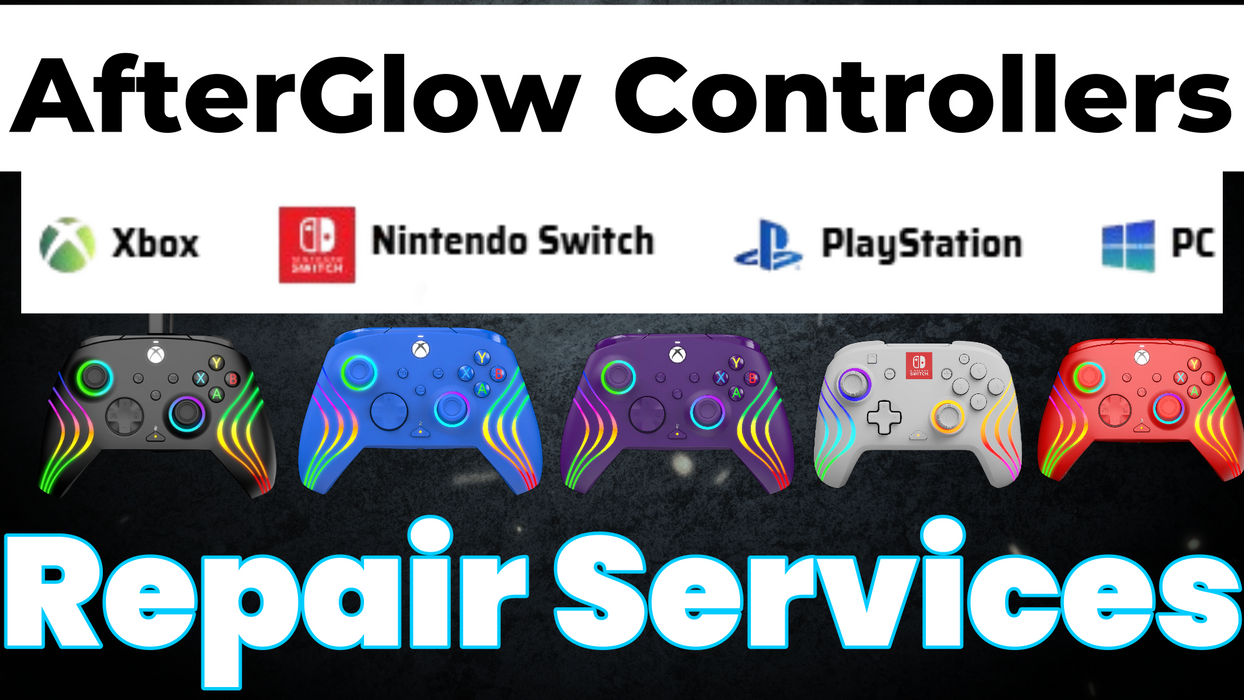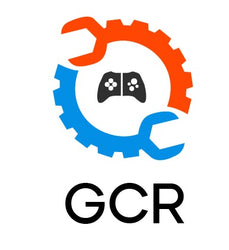

AfterGlow Gaming Controller Repairs
Get a FREE Quote
Afterglow gaming controllers, known for their customizable lighting and transparent designs, are popular among gamers. However, like any gaming peripherals, they can experience a variety of issues over time. Below are the common problems associated with Afterglow gaming controllers and their possible solutions:
1. Analog Stick Drift
- Problem: The analog sticks register movement even when they are not being touched, causing characters to move on their own.
- Cause: Worn-out or dirty potentiometers in the analog stick module.
- Solution: Clean the analog sticks with compressed air or contact cleaner. If the drift persists, replacing the analog stick module may be necessary.
2. Unresponsive or Sticky Buttons
- Problem: Buttons become unresponsive, sticky, or require more pressure to work.
- Cause: Dust, dirt, or debris buildup under the buttons, or worn-out contact pads.
- Solution: Clean the buttons and their contact areas inside the controller. If the issue persists, replace the button contacts or rubber membranes.
3. Broken Trigger Buttons (L2/R2)
- Problem: The trigger buttons (L2/R2) either don’t respond or get stuck.
- Cause: Mechanical wear, dirt buildup, or broken trigger springs.
- Solution: Open the controller and inspect the trigger mechanism. Clean or replace any damaged parts, including springs or trigger modules.
4. D-Pad Malfunction
- Problem: The D-pad is too sensitive or unresponsive during gameplay.
- Cause: Misalignment, dirt under the D-pad, or worn contacts.
- Solution: Clean the D-pad and realign it. If necessary, replace the D-pad assembly.
5. Loose or Worn Thumbsticks
- Problem: Thumbsticks feel loose, wobbly, or lack precision.
- Cause: Wear and tear from extensive use.
- Solution: Replace the thumbstick modules or caps if they are worn out.
6. Lighting Issues (LED Not Working)
- Problem: The customizable LED lighting stops working, flickers, or won’t change colors.
- Cause: Electrical faults or software issues with the lighting system.
- Solution: Check the controller settings to recalibrate the lighting. If the issue is hardware-related, the LED circuit or wiring may need repair or replacement.
7. Wireless Connectivity Issues (For Wireless Models)
- Problem: The wireless controller disconnects randomly or fails to connect to the console.
- Cause: Interference, low battery, or outdated firmware.
- Solution: Re-pair the controller, update firmware, or replace the battery if necessary. Move away from sources of wireless interference.
8. Charging Problems (For Wireless Models)
- Problem: The controller fails to charge, or the battery depletes quickly.
- Cause: A faulty battery, damaged charging port, or defective charging cable.
- Solution: Test with a different cable or power source. If the controller still doesn't charge, replacing the battery or charging port may be required.
9. No Vibration or Weak Feedback
- Problem: The controller's vibration motors don’t work, or the feedback is weak.
- Cause: Disconnected or faulty vibration motors.
- Solution: Open the controller to check the connections to the motors. Reconnect loose wires or replace damaged motors.
10. Headphone Jack Issues
- Problem: The headphone jack does not work, or there is static in the audio.
- Cause: A loose or damaged headphone jack or internal wiring.
- Solution: Clean the headphone jack with compressed air. If the issue persists, the jack or related wiring may need to be replaced.
11. Loose USB Connection (For Wired Models)
- Problem: The wired controller disconnects or stops working if the USB cable is moved.
- Cause: A loose or damaged USB cable or port.
- Solution: Test with another USB cable if removable. If the cable is permanently attached, re-solder or replace the internal wiring or USB port.
12. Calibration Issues
- Problem: Inputs from the analog sticks or buttons seem inaccurate or out of sync with in-game actions.
- Cause: Miscalibration of thumbsticks or triggers.
- Solution: Recalibrate the controller through the console or PC settings. If the issue persists, the analog sticks or triggers may need to be replaced.
13. Failure to Power On
- Problem: The controller does not turn on, even when plugged in or charged.
- Cause: A dead battery, faulty power button, or internal circuit issue.
- Solution: Replace the battery (for wireless models), check the power button, or inspect the internal circuitry for damage.
14. Overheating
- Problem: The controller becomes unusually hot during extended gameplay sessions.
- Cause: Internal electrical faults or prolonged use without proper ventilation.
- Solution: Take breaks between gaming sessions to allow the controller to cool down. If overheating continues, inspect the internal components for electrical issues.
15. Non-Responsive Paddles (For Advanced Controllers)
- Problem: The rear paddles on advanced models stop responding or do not register inputs.
- Cause: Worn-out or broken paddle mechanisms or improper configuration.
- Solution: Reconfigure the paddles using the controller’s software settings. If hardware failure is suspected, the paddles or their internal connections may need to be replaced.
16. Cosmetic Damage
- Problem: The transparent casing or LED lighting system shows scratches, cracks, or other forms of cosmetic wear.
- Cause: Accidental drops or prolonged use.
- Solution: Cosmetic damage typically doesn’t affect performance, but if desired, replacement shells or repairs can restore the controller's appearance.
17. Input Lag/Latency
- Problem: Inputs from the controller seem delayed compared to in-game actions.
- Cause: Wireless interference (for wireless models), outdated drivers, or poor connection.
- Solution: Use a wired connection if possible, update drivers/firmware, or change the wireless environment to reduce interference.
18. Loose Housing or Rattling Sounds
- Problem: The controller housing feels loose, or there are rattling sounds inside.
- Cause: Loose screws or internal components.
- Solution: Open the controller to tighten any loose screws or secure any components that may have become dislodged.
19. Sticky Triggers or Shoulder Buttons (L1/R1)
- Problem: The shoulder buttons or triggers get stuck or are difficult to press.
- Cause: Dirt buildup or worn-out springs in the button mechanism.
- Solution: Clean the button mechanisms and replace springs or other worn parts as necessary.
20. Firmware Update Issues
- Problem: After an update, the controller fails to function properly or becomes unresponsive.
- Cause: Corrupt firmware or failed update process.
- Solution: Attempt a firmware rollback or reinstall the firmware. If the controller remains unresponsive, a professional repair may be needed.
Conclusion:
Afterglow gaming controllers, while stylish and functional, can face a variety of common issues, ranging from analog stick drift to LED lighting problems. Many of these issues can be resolved with cleaning, calibration, or part replacements. For more severe issues, such as power failures or internal circuit damage, professional repairs may be necessary. Regular maintenance and proper care can help extend the lifespan of these controllers.
If unable to resolve the issue with your AfterGlow Gaming Controller, book now and let us get your controller up and running in no time
Product Reviews
Add customer reviews and testimonials to showcase your store's happy customers.
Author's name
Add customer reviews and testimonials to showcase your store's happy customers.
Author's name
Add customer reviews and testimonials to showcase your store's happy customers.
Author's name
